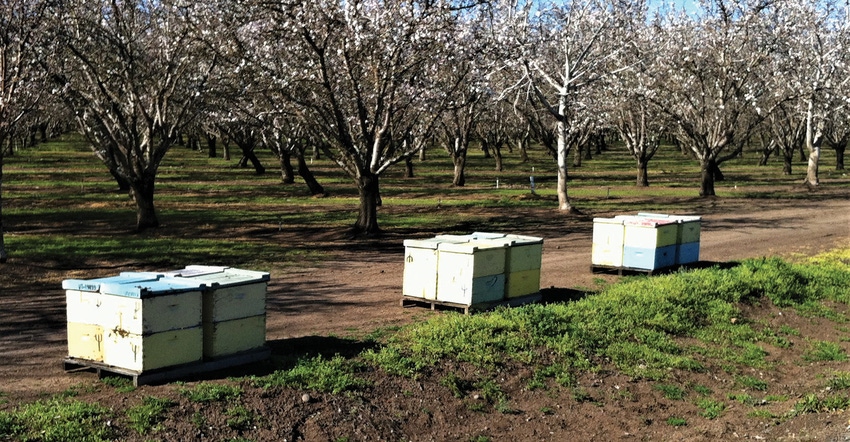
Although well in advance of annual Pollinator Week celebrations (in June), we’re approaching that time of year again when a couple million hives on trucks head West to the Central Valley to pollinate thousands of almond trees.
They arrive in late January and early February and earn their keep daily before their shift ends sometime around mid-March “when 90% of the flowers on the latest blooming variety are at petal-fall stage” according to the Almond Board of California’s Honey Bee Best Management Practices.
ABC calls it “the world’s greatest pollination event”. California Pollinators modestly notes it to be, “the largest pollination management program in the world.”
Hives generally stay in the million or more almond acres until growers tell them they’ve done the job. According to ABC, “Flowers are no longer able to set nuts when anthers without pollen dry up and turn light brown in contrast to their yellow and fuzzy look. At that point, a visit is futile as anthers are no longer receptive to pollen.” Industry practice is to release hives when 90% of flowers on the latest blooming variety are in petal fall stage.”
One of the busiest bees hovering over the activity is Steven House, master beekeeper and Operations Director at California Almond Pollination Services in Modesto, pollinator providers for almonds as well as plums, cherries and watermelons.
“We’re bee brokers,” said House. “We winter about 4,000 hives and starting in early January, begin to receive another 16,000 hives from all over the country headed for the Central Valley. We’re a link between beekeepers and nut growers.”
With almonds expected to bloom somewhere about the first of February, things are starting to get very busy. “We have 20,000 hives to place in over 120 different orchards all within about four weeks, starting with early January 15th placement --- or by February 15th for the late bloomers.”
Hive health a concern
The numbers of hives and their health have been prior issues of concern and continue to remain so. “We maintain high standards and only a small percentage of beekeepers can meet them and qualify as a healthy hive. For almond pollination, we rent out minimum hives of six frames with the average being eight frames and we can’t use hives with lower frame counts because they don’t pollinate properly.”
With the tree nut industry in a constant state of flux because of water, weather, workers, and a host of other problems, will bee pollination be on that list this year?
“In general, no,” he said. “The big issue this year among beekeepers is the price of fuel and the cost of shipping bees from, say, Florida to California. At today’s per-mile prices, it could cost $8,000 or $9,000 just to ship 400 hives one way and that’s assuming you can find a transport vehicle and a trucker that knows how to long-haul bees. They need to be watered each day and if too much sun appears with higher temperatures, they can get cooked. This is a delicate cargo to have on board.”
Current concerns notwithstanding, House expects 2022 pollination to run as smoothly as it did last year when the bloom came in early. “Looking at national weather surveys, we expect pretty much the same type of year ahead as we encountered last year in terms of bee flight hours --- the more hours there are, the better the pollination will be and last year was as good as it gets, almost perfect. We’re hoping for a repeat in spring 2022.”
About the Author(s)
You May Also Like




